 BMW Motorcycles
BMW Motorcycles
By Rob Beach
Daily I speak with North American riders about touring in Europe. The conversation naturally comes around to the motorcycles themselves, and what type and model is best on tour. The sort of things I hear regularly are:
- "I have ridden in the Rockies and the Appalachians on my 'Wing (or Dresser, or LT, or...) and I had no problems. A tour in the Alps will simply not be palatable for me nor my passenger without the type of bike I ride here."
- "I need a big machine for my passenger's comfort."
- "A full fairing is a must - I hate to be beaten up by the wind."
- "The bike must have a backrest. We simply can't ride two up without a backrest."
- "I need a shorter bike, so that I can get both feet on the ground."
- "We are big people - I need a lot of power to pass."
For most North American riders, a ride in the European Alps is the dream tour.
And of course on a dream tour one should ride a dream motorcycle: a big, comfortable bike for you and your passenger, a grand ride for a grand trip. And I agree—both you, and your passenger, should be as comfortable as possible throughout the tour. I know how Gretchen gets when she isn't happy on the back.
Comfort, when riding, is the sum of many factors. The ergonomics of a bike have quite an effect on rider and passenger comfort. You know how delightful a ride is when you are comfortable. Maybe you have had the unfortunate experience of also knowing how miserable it can be when you are not comfortable. And you have likely addressed whatever it was that made you uncomfortable after that experience. A new seat... bar backs... lower foot pegs, a different windshield, better rain gear, electrically heated clothing, etc...
And now the bike is set up properly, the gear is in order, and you are comfortable in the type of riding you normally encounter at home, or on trips to your favorite destinations.
However, when the destination changes, so does the comfort level of the setup you are used to using.
Funny things happen:
- "This big bike is a bit harder to move around when the parking areas are smaller, or (gasp!) gravel."
- "My vented suit that works well in Arizona or Florida isn't quite the ticket up here on top of a mountain pass in the Rockies."
- "Our topbox makes it really difficult for my passenger to get on and off... on our normal rides, we go for 2-3 hours at a time before stopping. This sightseeing, with the "on the bike, off the bike" is making her crazy."
- "Thanks to these floorboards there isn't much ground clearance. That wasn't important when we were riding around in the Midwest, but on these twisty roads over the hills of Appalachia they do seem to get in the way."
- "I sure wish I had a bit more air flow around this big windshield. It is really hot here in the desert."
- "Wow! In these curves, when she leans back on the backrest this bike handles like a bowl of jello!"
If you haven't experienced problems like these you may be spending too much time riding too close to home! (The fact that you are reviewing our website is a big step in fixing that.) But you can see how different circumstances can make a difference in comfort. What works well in one place may be an inconvenience, or worse, a true liability, somewhere else.
My mission, with this article is to explain some of the differences between riding in North America and riding in Europe.
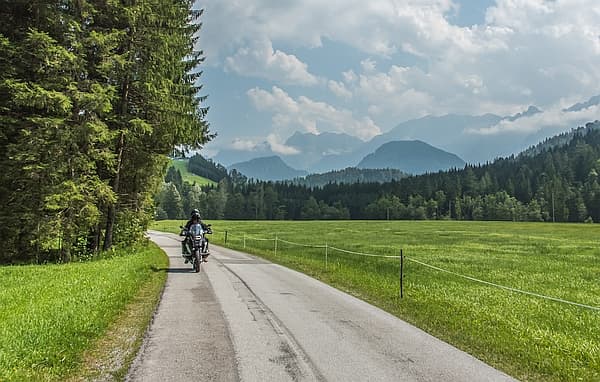
A typical German country road.
Would you really prefer a Goldwing here?
Factors such as roads, terrain, and speed also have a big bearing on comfort.
Being in a cocoon of still air is important to comfort while riding 300 miles in a day at 70 mph on the Interstate. It isn't important when one is riding at 40 mph.
Having a perfectly form fitted seat is a big benefit when cruising down the road with a steady throttle. As the pressure points don't change over the course of the day, the seat needs to compensate. On twisty roads where there is no steady throttle riding those pressure points change frequently. Bikes that I can spend weeks on in the mountains (in comfort) have proven to be horrible after 15 minutes on the highway.
Europe in general, and the Alps in particular, will be the most challenging motorcycle ride many riders ever take. The challenges particular to the Alps may be summed up with two words: tight, and narrow.
I have ridden road XXX on my YYY... so there is no doubt I can ride the Alps on that same type of bike.
There are few roads in the United States that can be used as a comparison to European roads. Deal's Gap? A great section of pavement, to be sure, but a bit wider than some of the neatest Alpine roads.
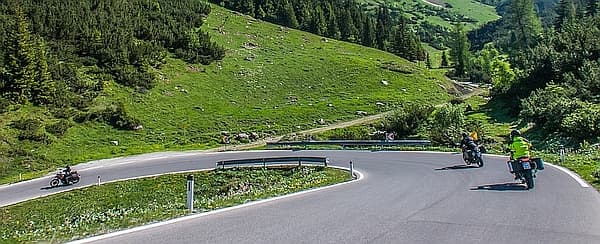
A turn posing as a hairpin
Do you ride many roads without shoulders (paved, or unpaved)? Few roads in the Alps have shoulders, and those that do are almost all in Switzerland. Sometimes there isn't space for two individual lanes, much less a shoulder.
Here is a photo of a hairpin - a nice, tight corner of the type encountered in the Alps. Imagine crossing 3 or 4 mountain passes daily, and encountering between 5 and 40 of this type of turn on each side of each pass.
There are other routes available in some places. Often, however, the only way from A to B is over a pass, a road with 10, 15 or even 21% grades and heaps of this sort of corner. One of the remarkable aspects of riding in the Alps (in contrast to say, the Rockies) is that you don't ride down a valley looking at the mountains, but you crawl all over the mountain, spending lots of time looking down at the valley!
Opps - did I actually caption that photo as "hairpin"? You could park a tour bus on the inside of that turn. My apologies... that is not a hairpin, but (by European standards) a simple 180° corner. A real hairpin turns around a radius about that of a coke can, and throws serious elevation change into the equation. You may have noted that there is a radius difference of about 15 feet between these two corners.
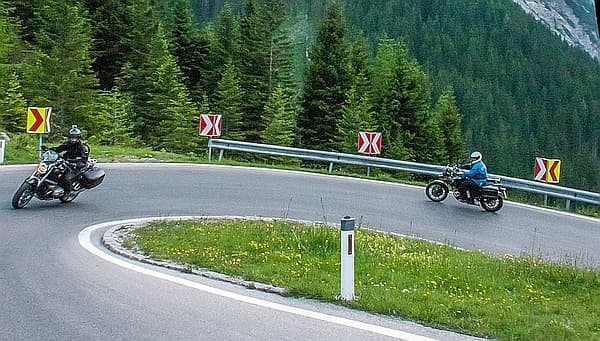
Almost a real hairpin
The road depicted in the 2nd image is also a two way road. There can be, and often is, traffic coming in the other direction. You may have noted that there is a radius difference of about 20 feet between these two corners.
I need a big machine for my passenger's comfort.
This comment is normally followed by a request for an R 1250 RT, or a K 1600 GT. While putting together the specifications for the various bikes on this page I was quite surprised to discover that the wheelbase of the R 1250 RT, (one of the larger bikes in our fleet), and the F 900 R (one of the smallest fleet bike) differ by 1.38 of an inch and the F 900 R is the longer of the two! The RT is a larger bike than the F 900 R, to be sure. But the differences are in width, bulk, and length over the back end of the bike, not in the wheelbase.
BMW motorcycle specification comparison
Dimensions in inches / mass in lbs.
| Model | Overall length | Overall width | Wheelbase | Wet weight (lbs) |
|---|---|---|---|---|
| K 1600 GTL | 97.99 | 39.37 | 63.7 | 771 |
| R 1250 RT | 87.48 | 38.78 | 58.46 | 615 |
| R 1250 R | 85.24 | 34.65 | 59.64 | 526 |
| R 1250 GS | 86.89 | 37.5 | 60.03 | 549 |
| F 900 R | 84.2 | 32 | 59.7 | 465 |
| F 750 GS | 88.78 | 36.3 | 61.38 | 494 |
The RT is not inherently more comfortable because it is bigger, as the "size" is largely a matter of perception (and expensive to replace plastic). It is heavier and offers less ground clearance than either the R or GS. Both of these differences are liabilities in the Alps.
BMW's flagship is the K 1600 GTL. It is an massively powerful, very impressive motorcycle packed with fascinating technology. Note how much larger it is than the different models of BMW twins. It handles brilliantly—for a large touring motorcycle. A 770 pound motorcycle.
On ultra-twisty Alpine roads each extra pound means more work for the rider, no matter how nicely the bike handles. In the mountains, in parking lots, on tiny, slow roads the GTL looses much of its luster.
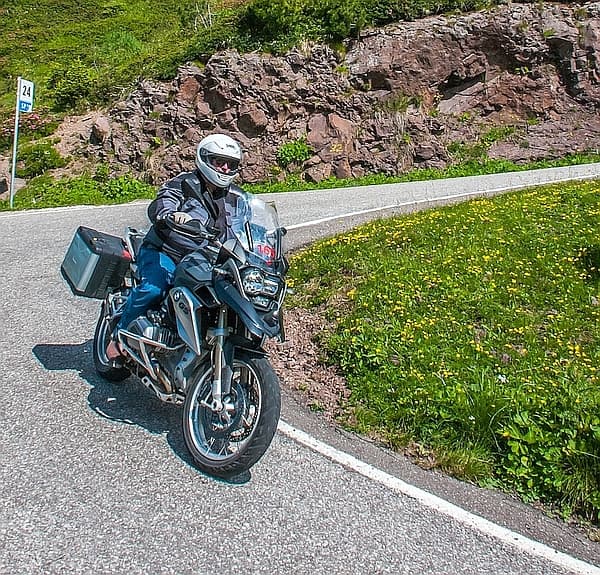
Let's add a bit of elevation change to make it more interesting!
When this was originally written (in 2007) the F800 series was newborn with BMW's introduction of the F800S. Since then BMW has introduced other F series models that are wonderfulmachines for Alpine riding. I have had the opportunity to complete a number of tours on both the F 900 R and the F 800 GS. These bikes have enough power to make you smile (or grimace in fear!), yet are light enough to be a mostly effortless joy to ride in the mountains. In short, the F series are highly recommended bikes for European touring.
In 2018 the F 750 GS was introduced, and in 2024 that was updated to the F 800 GS. With a lower seat height than the F 850 GS it has become one of the most appealing bikes in the fleet—especially for solo riders.
None of this is meant to take attention away from the other truly excellent bikes in the fleet lineup. The R 1250 R, R 1250 GS, R 1250 RS, and the S series are all very capable in the Alps. Rather, the intent is simply to make the point that more isn't better "just because."
A full fairing is a must—I hate to be beaten up by the wind.
Ponder your average ride at home. Is it an hour or more at a reasonably steady speed, say between 45 and 65 mph? Under those circumstances, a fairing and windscreen add considerable comfort to the ride. Sitting upright in even a 50 mph windblast can be fatiguing.
Fact: Your average moving speed over the course of an Alpine Adventure will be under 35 mph. That will be true even if you are riding solo and briskly all day long. Simply puttering along, your average moving speed, over 2000 miles and two weeks of riding, will be at or under 30 mph. These speeds are imposed by the roads traveled, not by us as guides or tour operators.
On a Beach tour you will be encouraged to ride at your own pace, on your own choice of itinerary. Yet even without knowing you or how you ride, I stand by that speed estimate.
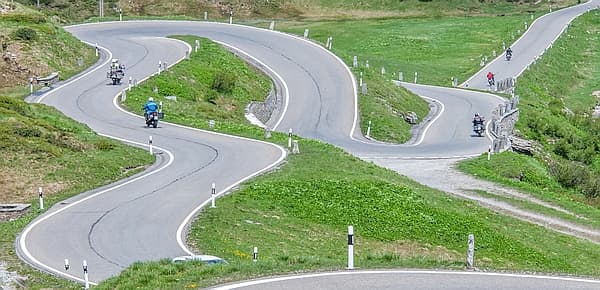
It really is that twisty
At speeds as low as these, the fairing offers little, if any, advantage. Rarely will you be traveling at speeds high enough to take advantage of the excellent BMW aerodynamics.
When traveling on the German Autobahn or the Italian Autostrade, the RT is the bike of choice. It is quite comfortable on the highway, and at those higher speeds the fairing makes the ride effortless. Even more fun is the K 1600 GTL, which simply howls down the autobahn.
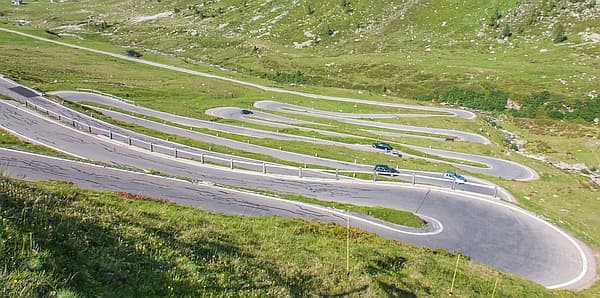
Another series of hairpins
On tour (in the mountains) my last choice of a mount is the GT, second last choice the RT. On the smaller roads the weight and bulk of the RT means it must be horsed around corners and it takes more effort to accelerate and decelerate. Riding it takes quite a bit more effort than the R or GS.
You will find the roads themselves require substantially more riding effort than you normally expend. Don't compound the work by adding weight and bulk on the motorcycle. Small and light is much easier to handle.
The bike must have a backrest. We simply can't ride two up without a backrest.
There are very few backrests seen on European bikes in the mountains, in contrast to the states, where few touring machines are without them. Many American riders are used to motorcycles so large that there is room for a backrest between the rider and passenger!
A passenger leaning on a backrest is a pendulum pivoting on the seat of the bike, reacting to directional and speed changes after the fact. A passenger in the proper position (close in behind the rider, holding on to him/her) participates at the moment.
This participation makes HUGE differences in the way the bike handles, and also in the passenger comfort (really). But it is also very different than the riding style we have become accustom to in the states, with huge bikes, backrests for the passenger AND rider, and a zillion miles of droning on the highway.
Alpine riding is pure, active, you (and passenger) got-to-pay-attention sort of riding. Backrests simply don't fit into that equation, as they promote a much lazier form of passengering.
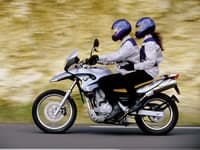
Small bike
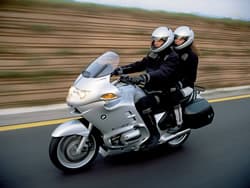
Large bike
Togetherness
2 up on a big bike or a small bike,
the proper riding position is identical.
Often the passenger feels uncomfortable because movements of the bike surprise them. The rider's responsibility is to offer notice of changes (via consistency in machine operation). In reality, riders always send lots of signals that something is about to happen. But with the passenger physically removed from the rider those signals don't "jump the gap", and that equals a surprised passenger.
Riders often use a backrest as a crutch. "My passenger feels more secure with a backrest" too often means "I am not a smooth rider able to instill confidence in my passenger, but the addition of a backrest makes her feel better."
A bit of a different approach to riding two-up will pay off handsomely in the Alps. Having your passenger up close is romantic, and, more importantly, allows the bike to handle properly in the zillions of corners you will encounter.
Becoming a more refined, smoother rider will also add to your passenger's comfort.
Examine the two photos (Togetherness) of BMWs being ridden two up. Notice that the rider/passenger combination on the RT ("big bike") are "as one" as the couple on the F 650 ("small bike").
Toss the backrest and, after a day of adjustment, you, as rider, will be MUCH happier. I guarantee it will seem as though your riding skill has increased 25%—instantly. An active passenger makes that much of a difference.
After all that is said, we can't equip your machine with a backrest, but we may be able to install a topbox on it - but do think long and hard about it before having this crutch installed. The bike will handle much better without it, and the passenger will be able to get on and off the bike much easier without having to work around a backrest or topbox.
I need a low seat height so that I can get both feet on the ground.
I'll level with you—there is no place level in the Alps. With parking lots built at an angle, roads cambered in all sorts of directions, and elevation differences everywhere, rarely is a rider able to stop with both feet on the ground on anything but the very shortest bike. Short bikes have ground clearance problems, and ground clearance is critical on twisty Alpine roads. That is why you don't see cruisers in our fleet - they are simply too low for twisty back-road riding.
Learn to balance—really balance, in a way we rarely have to here. Don't depend on having both feet on the ground at one time. Motorcycling is about balance, and over 85% of the "accidents" we have on tour are simple tipovers, caused by riders who don't have confidence in properly balancing a bike, and who have come to depend on short bikes, and both feet on the ground as their "landing gear."
Learn to stop—every time—with only one foot on the ground. Passenger or no passenger, regardless of the road surface, irrespective of the terrain - only one foot on the ground. Then, you not only will be unfazed by the seat height of the BMWs, but you will go home without paying me (or another tour operator) a damage invoice for that silly tip over.

Notice that my son Jake's
left foot is about 18" off
the ground. He actually can't
even reach the left footpeg
in this position. Ahh, a kid's
confidence, eh?
Can't do it, you say? Yes you can - Jake can, and he was only 9 years old in this photo. You can too. Believe in yourself!
And now, the tip promised ever so long ago:
Riders above 5'10" tall should look at the R 1250 GS, R 1300 GS, or the F 850 GS. - they are the most versatile of BMW's line, and perfect for the Alpine roads. Shorter riders should consider the R 1250 R or the F 900 R, or the F900 XR, as the GSs are rather tall machines.
Competent, confident, well-balanced riders of shorter stature will also find the GS to be enjoyable, albeit a bit more work in the parking lot than the R.
Solo, or inseam challenged, riders should look at the F 900 R, F 800 GS, or R 1250 R as an ideal ride. The power to weight ratio is very favorable, the bike is quite narrow, and it is very easy to handle on the Alpine roads. Repeat tour members riding solo often ask for the 800 or 900 cc bikes on their second trip. It took them 2 weeks of exposure to understand Alpine roads, and the next time around they realize that smaller & lighter really is better!
In 2024 Gretchen and I rode a number of different bikes on tour. We started with an F 800 GS, then rode the F 850 GS, R 1300 GS, R 1250 GS, and R 1250 R on successive tours. I liked each for various reasons, while Gretchen has her own preferences. Funny though, we agree the F 800 GS was one of the best all-around machines.
You are interested in a European tour because it is different, it is challenging, and it is magical. Consider that the differences encountered may be so big that different thinking, and changes in habit may (will) be required. Ideas such as "my space" on the road will be challenged. Habits such as big bikes, backrests and big windscreens, nice or necessary here, are not important there.
Now let's get out and ride - really ride, as one cannot in the States!
© 2023. Beach's Motorcycle Adventures, Ltd. All Rights Reserved.

 BMW Motorcycles
BMW Motorcycles